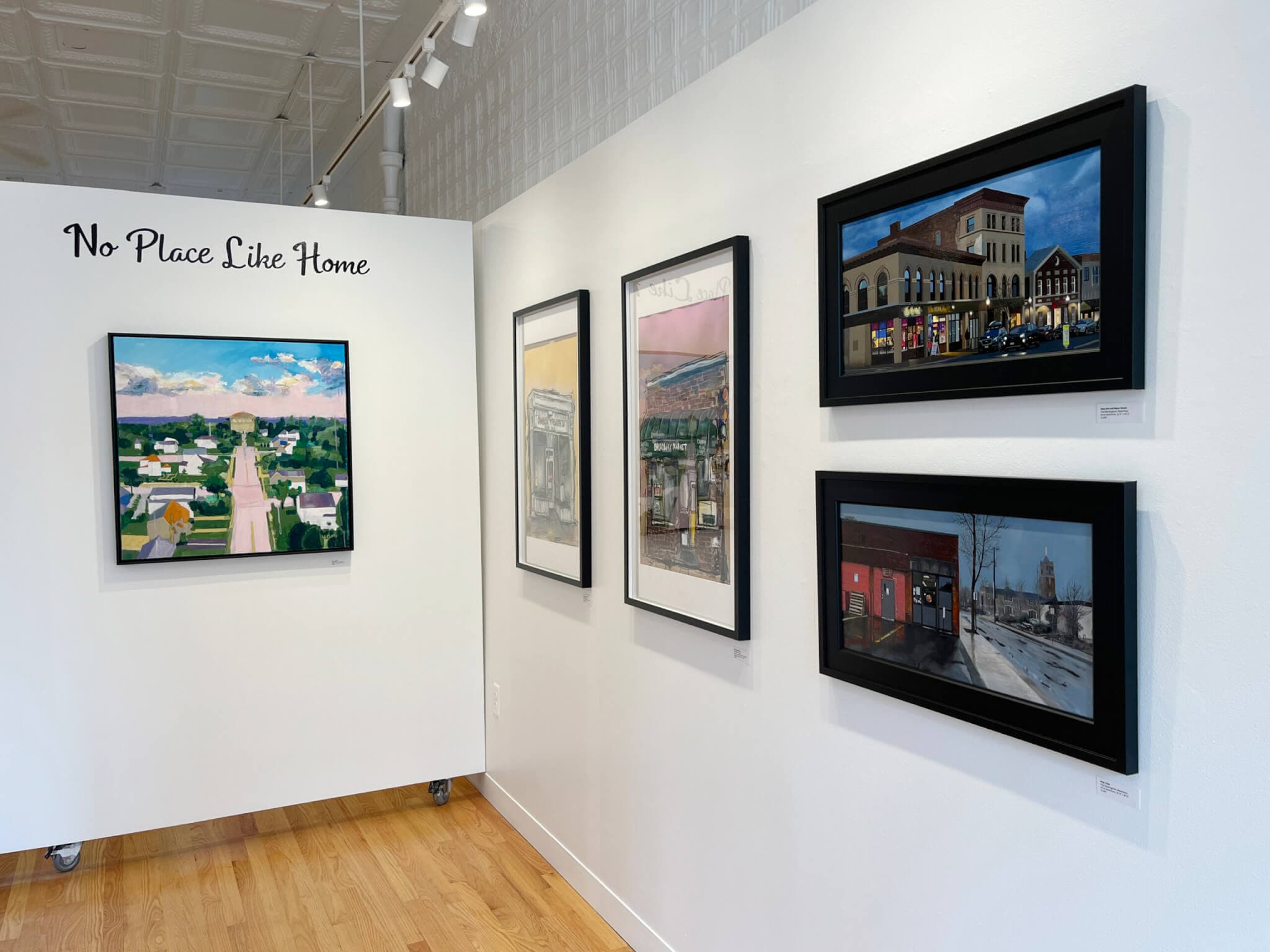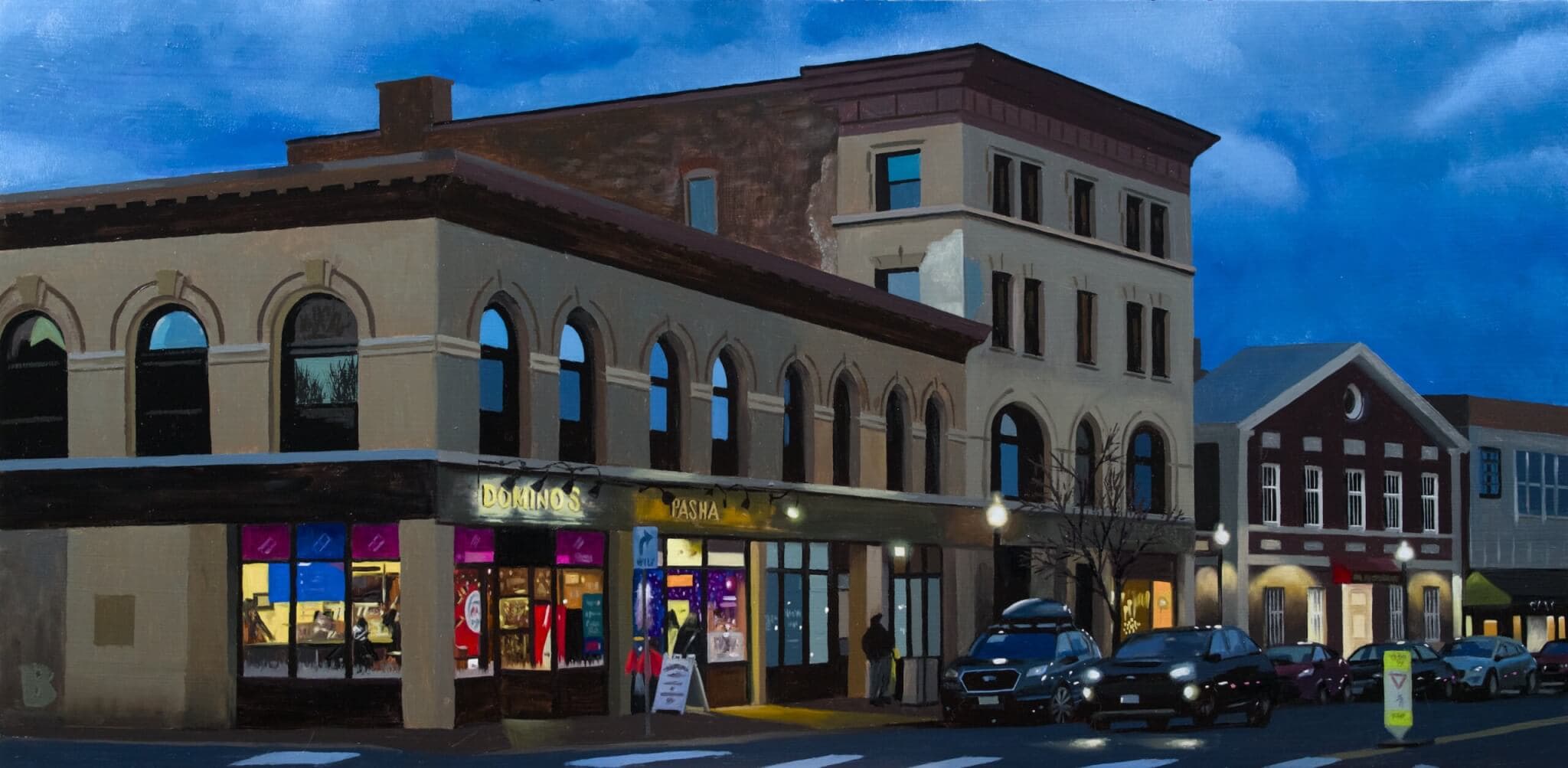“No Place Like Home” at Arlington’s 13FOREST Gallery is a small show that’s sure to be of most interest to people who live in the town, but it got me asking questions that don’t feel small. What counts as a local landmark? What contributes to the character of a neighborhood? When and how do purveyors of goods and services serve the greater good? I mulled these matters as I looked at the sixteen paintings on view, all new works created for this show in response to a prompt. The gallery invited three artists—Paul Beckingham, Bonita LeFlore, and Kayla Myers—to make paintings of recognizable locations in Arlington of their choosing. None of the artists live in the town, which struck me as strange at first. But then I realized that each artist uses the built environment as a major source of inspiration for their practice, in quite different ways, and the show turned into an opportunity to see through their distinctive perspectives and look through my own with fresh eyes.
Online • Aug 27, 2024
In “No Place Like Home,” Three Artists Present Fresh Perspectives on the Streets of Arlington
At 13FOREST Gallery, Paul Beckingham, Bonita LeFlore, and Kayla Myers responded to a prompt to paint recognizable locales in the town, but the resulting exhibition offers more than just pretty postcards.
Review by Jacqueline Houton
Installation view, “No Place Like Home,” 13FOREST Gallery, 2024. Photo courtesy of 13FOREST Gallery.

Installation view, “No Place Like Home,” 13FOREST Gallery, 2024. Photo courtesy of 13FOREST Gallery.

Kayla Myers, Broadway Market, 2024. Acrylic, spray paint, charcoal, pastel, collage on paper. Photo courtesy of the artist and 13FOREST Gallery.

Kayla Myers, Cambridge Typewriter Co., 2024. Acrylic, spray paint, charcoal, pastel on paper. Photo courtesy of the artist and 13FOREST Gallery.
Boston-based artist Kayla Myers often creates expressive mixed-media homages to small businesses that serve their neighborhoods, preserve the culture of their communities, and increasingly face risk of displacement—mom-and-pop restaurants, hair-braiding salons, the corner market open seven days a week. For this project, she embarked on extensive research before selecting the bygone Brigham’s ice cream shop, the Broadway Market convenience store, D’Agostino’s deli, the Capitol Theatre, the Book Rack used bookstore, and the Cambridge Typewriter Co. repair shop. Myers initially learned of the last on that list from a May article in the Globe, which described longtime proprietor Tom Furrier’s decision to retire after forty-four years and his hope to find someone to carry on the business. The actual storefront is tucked on Mass Ave between a house and a chiropractor’s office, but Myers, working with a limited but potent palette of black, white, red, and yellow, depicts the shop standing alone, telegraphing that it’s the last of its kind. Though the sign on the door says “Open,” the interior is shadowy, largely vacant; we can’t see the marvels of machinery that, with expert care, keep working decade after decade, so unlike the laptops often tossed in landfills after five years of use. The dark lines Myers uses to render the millwork make the white exterior look worse for wear, but the background shines in shades from lemon yellow to saffron, lending undeniable warmth to the scene. Depth and texture accrue in acrylic, charcoal, pastel, and spray paint, which drips down one side like a squeeze of sunshine. The grunge heightens the glow in a way that feels tender and fitting for a place that hosted marriage proposals, a place that seemed like a wonderland for many local writers, whose names you could spy on cards by their waiting Royals and Underwoods. A similar warmth suffuses her painting of the Book Rack, lit up with sunset colors as paint dribbles down like melting vanilla, chocolate, and strawberry ice cream. This, Myers seems to say, is a place of pleasure and delight.

Bonita LeFlore, Movie Night, 2024. Acrylic and pastel on canvas. Photo courtesy of the artist and 13FOREST Gallery.
Bonita Leflore, an artist based on the North Shore, often paints aging architecture, giving glow-ups to dilapidated barns and sagging structures that might be called eyesores, locating beauty in imperfection and impermanence. Here, in her acrylic-and-pastel paintings of the Wood and Strings Music Center, the Arlington Reservoir Water Tower, the Cyrus Dallin Art Museum, and the Capitol Theatre, perspective sometimes turns kaleidoscopic (showing us the front and side of the Dallin Museum simultaneously, for instance), and vibrant palettes pull from imagination as much as observation. Consider the juicy tangerine and pops of teal and cobalt in her take on the Capitol, a six-screen movie house that will turn one hundred next year. The inviting colors and abstracted geometry of the painting had me contemplating the many sides of this place and the different ways it welcomes the community. The Capitol has an ice cream parlor as well as the standard concession stand. Mondays offer matinees so caregivers can watch a movie for grownups in a setting where babies can be babies. It’s a popular venue for birthday parties; you can rent out a whole theater for about the same price as a nice dinner for two. On Saturday nights, you can catch DIY music and live visuals courtesy of the 4th Wall. And the next morning, you might find a congregation worshiping there.

Paul Beckingham, First Parish Tower, 2024. Oil on aluminum. Photo courtesy of the artist and 13FOREST Gallery.
Watertown-based artist Paul Beckingham, by contrast, hews to realism in his six paintings; at a glance, you might mistake his rendition of the First Parish Unitarian Universalist Church’s bell and clock tower for a photograph instead of oil on aluminum. The strong lines of the modernist structure—which shocked some when it debuted in the mid-1970s in the center of town, on a corner that’s held one meetinghouse or another for three centuries—rise into the sapphire blue of an evening sky, reaching toward the quarter moon. Most of Beckingham’s paintings here are nocturnes in which street lights and headlights and illuminated storefronts gleam in fading twilight. But the romance of all that shadow and light is balanced by the particularity of everyday (or everynight) details: the fliers posted on the front door of the Wood & Strings Music Center, the pallets leaning against the weathered exterior of Play Time arts and crafts supply. In a meta move, he includes a painting of 13FOREST, where twinkling lights in the windows frame gallery goers taking in the annual “Plenty” holiday show and sale. It’s one of the few paintings where human figures are visible, and it nods to the social function of a neighborhood gallery like this one. This isn’t a solemn white cube but a place packed with art and, often, people, who get frequent chances to meet the artists whose work is on view.

Paul Beckingham, Mass Ave and Water Street, 2024. Oil on aluminum. Photo courtesy of the artist and 13FOREST Gallery.
“No Place Like Home” is the sort of show that might get you thinking about the places you’ve lived and spaces that made them what they are. I moved to Arlington at the start of 2022 after fifteen years in Cambridge’s Central Square, a neighborhood I love and lamented as I saw indies shutter and artists and musicians evicted to make room for a video-marketing firm’s HQ. I was wary of moving to a suburb, especially as a nondriver, but I’ve found places to treasure here too. This show had me asking which ones I might choose as muses, like the bakery that opens at 6 am every day, where they know my coffee order and where a cord tied to the door handle loops around a hook on the wall: a tiny intervention that makes a big difference to a person navigating a doorway with a stroller. Or the boardwalk on the Alewife Greenway, where neighbors have planted native wildflowers and noted on a whiteboard what’s in bloom—bee balm and wild petunia, cup plant and cardinal flower. They’ve given me names for the beauty before me, and like the artists in this show, they’ve helped me know this place I’m calling home a little better.
“No Place Like Home” is on view at 13FOREST Gallery through September 13, 2024
